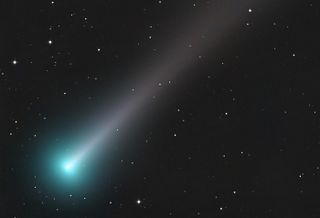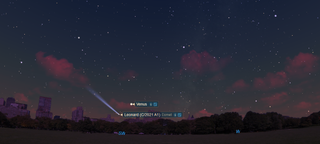
Comet Leonard spent the first couple of weeks of December visible as a target for observers with binoculars and telescopes in the early morning sky before sunrise.
Now, however, the viewing venue has changed and the newfound Comet Leonard (cataloged as C/2021 A1) has moved into the evening sky, visible low above the southwestern horizon about an hour or so after sunset. And tonight (Dec. 17), you can use one the sky's brightest beacons to locate it: Venus.
When December began, Comet Leonard's brightness was hovering at around magnitude +6.3 on the brightness scale used by astronomers. This value is based on an average of dozens of reports worldwide posted on the Comet Observation Database. A magnitude of +6.3 would make Comet Leonard just bright enough to be visible with the unaided eye by sharp-eyed observers under pristinely dark skies, although those with less-than-perfect viewing conditions could readily sight the comet with the aid of binoculars and a knowledge of where precisely to look using a good star chart.
Here are our recommendations for telescopes and binoculars to see Comet Leonard. If you want to prepare for the next comet or night sky sights in 2022, check out our guide for the best binoculars deals and the best telescope deals available now. Our guides for the best cameras for astrophotography and best lenses for astrophotography can also help make sure you're ready to photograph the night sky.
Related: Want to see Comet Leonard? Here are telescope and binoculars recommendations
A rapid uptick in brightness
Over the past couple of weeks as Comet Leonard approached both the sun and Earth, it has brightened rapidly. The comet passed closest to Earth on Monday at a distance of 21.7 million miles (34.9 million km) and now shines at magnitude +3.9 — a more than nine-fold increase in brightness since the start of the month, a placing it readily within range of naked-eye viewers.
Still, the comet may be difficult to identify for several reasons. First and foremost is its current placement in the sky, which puts it against not a dark background by one illuminated by evening twilight. Secondly, there is the presence of a bright nearly full moon rising in the east, adding its own glow to brighten the early evening sky.
Get the Space.com Newsletter
Breaking space news, the latest updates on rocket launches, skywatching events and more!
Venus as benchmark for making a sighting

Nonetheless, the comet will have an ally in helping you make a sighting of it, in the form of the brilliant planet Venus.
Currently, the dazzling "evening star" is readily visible low in the southwest sky shortly after sunset. And on Friday evening, hovering 5 degrees directly below it, will be Comet Leonard.
Since your clenched fist held at arm's length is equal to roughly 10 degrees in width, the comet will be positioned about one-half of a fist’s width below Venus.
Binoculars will be beneficial
We suggest you wait until at least an hour after sunset to hunt for Comet Leonard. First, locate Venus, then check out the region of the sky below it and see if you can spy the comet. What you will be looking for is not a sharp pinpoint of light like a star, but a small fuzzy patch of light, perhaps with a semblance of a short tail pointing almost straight up from the patch in the general direction of Venus.
If you cannot see the comet visually with your eyes, then scan the region of the sky below Venus with binoculars. You should almost certainly pick it up then … and a small telescope will accentuate the view of the comet's gaseous head (called the coma) and its tail. If your weather is cloudy on Friday, you can try using Venus to find the comet on Saturday evening, though it will no longer be below Venus but will have shifted a position to its lower left.
Comet Leonard will likely begin to fade and will gradually be lost to view thereafter, reaching its closest point to the sun on Jan. 3 at a distance of 57.2 million miles (92 million km), and once it rounds the sun it will be thrown out of the solar system into a slightly hyperbolic orbit, never to be seen again.
Brighter than most
Overall, Comet Leonard is a far cry from the spectacle that Comet NEOWISE evolved into back in the summer of 2020.
Leonard is much dimmer and its tail structure far inferior to that of NEOWISE. Nonetheless, compared to the vast majority of comets that pass through the inner solar system, Leonard can still be considered quite bright; at any given time more than half a dozen comets are visible to experienced amateur and professional astronomers, but most of these hardly develop any noticeable tail and are usually accessible only to those with moderately large telescopes. A comet like Leonard, that becomes bright enough to be glimpsed with the naked eye, are far less frequent, perhaps two or three every 10 to 15 years.
Editor's Note: If you snap an amazing comet or night sky picture and would like to share it with Space.com readers, send your photos, comments, and your name and location to spacephotos@space.com.
Joe Rao serves as an instructor and guest lecturer at New York's Hayden Planetarium. He writes about astronomy for Natural History magazine, the Farmers' Almanac and other publications. Follow us on Twitter @Spacedotcom and on Facebook.
Join our Space Forums to keep talking space on the latest missions, night sky and more! And if you have a news tip, correction or comment, let us know at: community@space.com.

Joe Rao is Space.com's skywatching columnist, as well as a veteran meteorologist and eclipse chaser who also serves as an instructor and guest lecturer at New York's Hayden Planetarium. He writes about astronomy for Natural History magazine, the Farmers' Almanac and other publications. Joe is an 8-time Emmy-nominated meteorologist who served the Putnam Valley region of New York for over 21 years. You can find him on Twitter and YouTube tracking lunar and solar eclipses, meteor showers and more. To find out Joe's latest project, visit him on Twitter.
